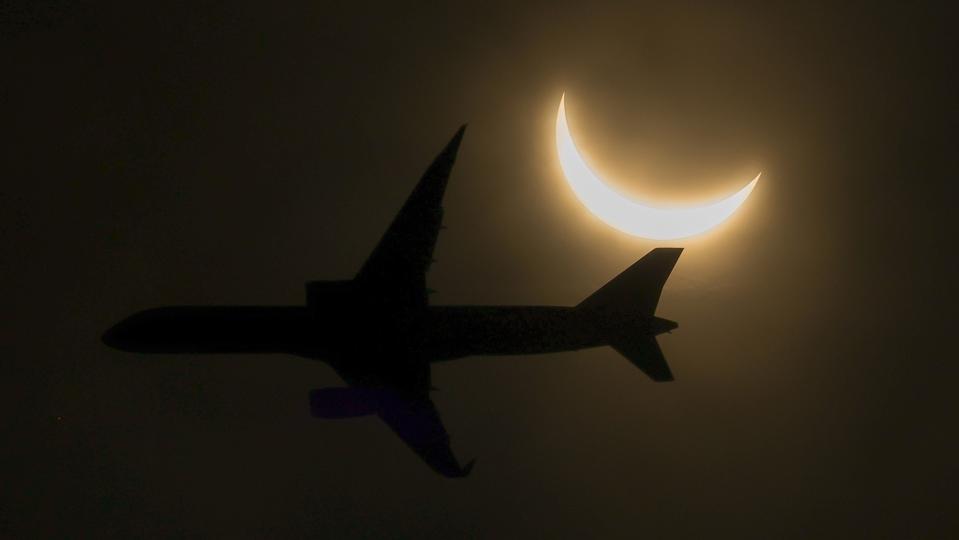


A rare sunrise solar eclipse will occur on Saturday, March 29, 2025, as a new moon partially blocks part of the sun as it appears. However, since the exact timing for any specific location will vary, online sources should be consulted in advance. Since at no point will all of the sun be blocked by the moon to cause a total eclipse, eclipse glasses and solar filters should be used at all times.
An airplane flies in the path of a partial solar eclipse while seen from Glen Rock on April 08, 2024 ... More
This first solar eclipse of 2025 will be seen in the U.S. between 6:13 and 7:17 a.m. EDT, and in Canada between 6:56 a.m. NDT and 8:20 a.m. EDT. Western Europe will see the eclipse in mid-morning.
The eclipse will technically be visible from 13 U.S. states in the northeast: Maine, New Hampshire, Vermont, Massachusetts, Rhode Island, Connecticut, New York, New Jersey, Pennsylvania, Delaware, Maryland, Washington D.C. and Virginia. An exact schedule for any location can be found on Timeanddate’s map of the eclipse.
The best views are likely to be had from the coastal areas of New England and Maine in the U.S., where the deepest eclipse will take place. Coastal areas and locations with high elevations are favored because the eclipse takes place at sunrise.
A big crescent sunrise will be seen from Maine, Massachusetts (up to 55%), New Hampshire (up to 57%), Vermont (up to 53%) and parts of New York (up to 45%).
Big cities that see the eclipse include Boston, MA (up to 43% with sunrise at 6:31 a.m. EDT), New York City (up to 22% with sunrise at 6:44 a.m. EDT), Philadelphia, PA (up to 12% with sunrise at 6:49 a.m. EDT), Concord, NH (up to 46% with sunrise at 6:32 a.m. EDT) and Portland, ME) (up to 64% with sunrise at 6:27 a.m. EDT).
From locations to the southeast, the eclipse will be barely noticeable, with the moon eclipsing Washington D.C. seeing just 1%. No eclipse is visible south of Virginia Beach, Virginia and east of Buffalo, New York.
The deepest eclipse in the U.S. will be from northeastern Maine, with an 83% eclipsed sunrise at Quoddy Head State Park in Lubec, Maine, at the easternmost point of land in the continental U.S. Observers here will see a phenomenon known as the “devil’s horns,” according to Timeanddate, where the only visible part of the sun will be a narrow crescent that resembles a pair of horns as it appears at sunrise in eclipse. Atmospheric distortion may stretch or flatten the crescent, creating an even more surreal view.
The eclipse will also be seen in eastern Canada. The point of maximum eclipse will be near Akulivik in Nunavik, northern Quebec, where a 93% eclipsed sunrise will be seen. The phenomenon of “devils’ horns” will be along the St. Lawrence River northeast of Quebec City and in southwestern New Brunswick close to the U.S.-Canada. Newfoundland will see a smaller eclipsed sunrise, with the eclipse deepening after.
Solar and lunar eclipses are always twins. This solar eclipse comes two weeks after March 13-14’s “blood moon” total lunar eclipse seen from North America (and from the moon by a spacecraft). The last solar eclipse in North America was the total eclipse of April 8, 2024. The following is a partial solar eclipse on August 12, 2026.

